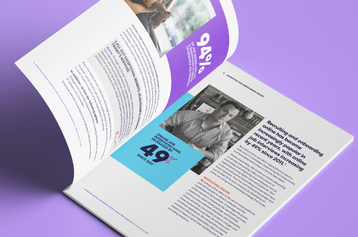
First impressions can have a lasting impact. Your company’s employee onboarding process is your chance to make a good first impression with new employees. This process should be about making the new employee feel welcomed, valued and prepared to succeed in their new role. A recent report by the Society for Human Resource Management showed that 1 in 25 employees leave their new jobs because of bad onboarding experiences.
Poor onboarding can have many disastrous effects. It can set a new employee up for failure, inhibit workplace efficiency and change an employee’s outlook on your company. The result can be high cost and even higher turnover rates.
Here are seven ways to improve your onboarding process for employee success.
1. Prepare for the new employee
A great way to prime your team for the new hire is to do a little pre-onboarding. Send your new employee an email they can voluntarily readand to let them know you’re excited to welcome them to the team, and provide a brief overview of how their first day will go. Be sure to announce the news to all employees, either in-person or via email, welcoming and preparing the new team member to their role, sharing a bit about their experience and what they’ll be doing, and encouraging employees to welcome them aboard.
When employees are aware of a new team member ahead of time, they can be prepared to assist them on their first day. This will go a long way in making the new employee feel welcomed and it’s one of the most crucial steps in the onboarding process.
Make sure you have all documents, forms, and notices that are required to be completed by, provided to, or acknowledged by the new hire ready on day one, such as the Form I-9, Form W-4, benefits notice and information, and Wage Theft Prevention Act notice, if applicable.
2. Have the new employee’s workstation ready to go
Having a “home base” ready for your new team member is crucial to an employee’s first impression of your company. As a new employee, nothing is worse than not having the tools you need to succeed. When employees don’t have an area to call their own, this can quickly make them feel as if they are not a part of the team.
Setting up the employee’s computer, email and phone ahead of time, and providing any necessary office supplies, can help a new colleague feel valued from day one and allows them.. This gives the new employee the tools to perform at their best.
3. Make sure your new employee has access to any necessary programs
In line with getting their workstation ready, be sure the new employee has access to any programs, software or electronic files they’ll need on their first day. By having a binder or electronic document ready for them to refer to, they won’t feel like they’re waiting around for the next set of verbal instructions. Overlooking this step can impede the training and onboarding process for new employees, stall their ability to get to work and, in turn, affect their outlook on your company. Although you shouldn’t go overboard with the to-do list on the first day, giving them access to essential programs and documents from the beginning helps them see your organization as prepared and professional.
4. Make introductions
Do your best to help new hires foster meaningful connections with their coworkers. Schedule some time for the new employee to meet with key people and departments on their first day. Although they may not remember everyone’s name, this will give them a good overview of where to go to get what they need. These introductions will also help them understand how your company works and how their role plays in the overall picture.
5. Plan a team lunch
Another great way to familiarize your team with each other is to plan something as a group. Arrange a lunch meeting or after-work gathering for the new employee and their immediate team members in the first week. This will help break the ice and allow the employees and your team to get to know each other in a relaxed environment. If you decide to do something out of the office, try to do it either during working hours or as an optional event. Check with your new hire’s schedule if you want to hold an after-work gathering, as you don’t want to suggest that your company doesn’t value work-life balance and remember that if they attend such a gathering, you may have to pay them for that time, including any potential overtime. Take the time to learn a little bit about your new employee outside of the interview process. When an employee feels valued by their team on a personal and professional level, they are more likely to stick around for the long haul.
6. Allow plenty of time for training
Don’t rush things. The first week during the new employee onboarding process should focus on training. Even if the employee has performed the same job function elsewhere, there are bound to be differences between companies. Having a training plan in place is a vital part of helping employees find their feet in a new organization. Your training should cover company rules, processes, procedures and expectations. By detailing what is expected from new employees, you’ll set a precedent by which they can measure satisfaction and success in their new role. Try to vary the training between reading, videos, assignments, shadowing and even mentoring. Everyone’s learning style is different and keeping things dynamic can help reduce first-day employee burnout.
Assigning a mentor from the employee’s department is another great way to help new hires acclimate to their job. This can be as simple as assigning them someone who is ready to answer their questions and walk them through some of their assignments. Or, if you’re looking for more thorough employee onboarding, you can have new hires shadow a mentor throughout their first week to get a better understanding of day-to-day processes.
7. Don’t forget to follow-up
This step in the onboarding process is the most important and often the most overlooked — follow -up meetings. Commit to 30-, 60- and 90-day check-ins with the new employee, even if the employee is doing well and you feel like they don’t need an evaluation. This is your opportunity to learn more about your company’s new hire onboarding process from the employee perspective. It also provides an opportunity to see how they’re doing; answer any questions they may have and make sure they’re on the right path in their new role. Find out what they liked and didn’t like about your process and make changes as you see fit.
Successful employee onboarding processes reflect the time and effort put into them. Take the time to be thoughtful and do your homework. The first few weeks are the most influential to a new hire’s outlook on your company—positive or negative—and sets the tone for their relationship with your business in the long-term.
Improving your employee onboarding process doesn’t have to take up too many resources. With a few strategic changes, you can improve your new hire’s first impressions of your company, which may help improve employee retention rates and even productivity levels. For additional guidance on employee experience, partner with TriNet and gain access to comprehensive HR solutions today.
This communication is for informational purposes only; it is not legal, tax or accounting advice; and is not an offer to sell, buy or procure insurance. This post may contain hyperlinks to websites operated by parties other than TriNet. Such hyperlinks are provided for reference only. TriNet does not control such web sites and is not responsible for their content. Inclusion of such hyperlinks on TriNet.com does not necessarily imply any endorsement of the material on such websites or association with their operators.






